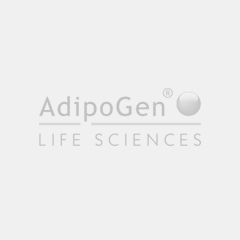Cookie Policy: This site uses cookies to improve your experience. You can find out more about our use of cookies in our Privacy Policy. By continuing to browse this site you agree to our use of cookies.
Bertin Bioreagent
anti-PPARγ1, 2, mAb (4A4)
As low as
777
CHF
CHF 777.00
In stock
Only %1 left
BRT-G01027-R100100 µlCHF 777.00

| Product Details | |
|---|---|
| Synonyms | Peroxisome Proliferator-activated Receptor gamma; Nuclear Receptor Subfamily 1 Group C Member 3 |
| Product Type | Monoclonal Antibody |
| Properties | |
| Clone | 4A4 |
| Isotype | Mouse IgG2bκ |
| Source/Host | Mouse |
| Immunogen/Antigen | Synthetic peptide coupled to ovalbumin. |
| Application | ELISA, Western Blot, Immunofluorescence. Recommended dilution: 1/500-1/5000 |
| Specificity | Recognizes human and mouse PPAR gamma 1, 2. |
| Formulation | Liquid. Does not contain any preservative. |
| Other Product Data |
Click here for Original Manufacturer Product Datasheet |
| Declaration | Manufactured by Bertin Bioreagent |
| Shipping and Handling | |
| Shipping | BLUE ICE |
| Long Term Storage | -20°C |
| Handling Advice | Avoid freeze/thaw cycles. |
| Use/Stability | Stable for at least 3 years after receipt when stored at -20°C. |
| Documents | |
| Product Specification Sheet | |
| Datasheet |
 Download PDF Download PDF |
Description
PPARγ is a ligand-activated transcription factor involved in the regulation of lipid homeostasis and may function as a master regulator of adipogenesis. PPARγ mRNA is expressed prominently in adipose tissue, but is also found in large intestine, kidney, liver, and small intestine. Alternative splicing of the PPARγ gene results in at least two mRNA species that differ at their 5' ends. Human PPARγ1 and PPARγ2 proteins are 53 and 57 kDa, respectively, based on the deduced amino acid sequences. PPARγ2 is the major PPARγ isoform found in both the cytosolic and nuclear fractions of undifferentiated 3T3-L1 cells. Total cellular PPARγ2 protein increases approximately 2-fold following differentiation of 3T3-L1 cells, whereas only small quantities of PPARγ1 are detected in the nuclear fraction following differentiation.





